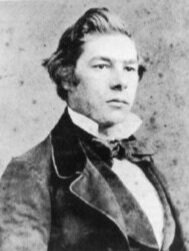BIOGRAPHY | EADWEARD MUYBRIDGE
Eadweard Muybridge, then Edward James Muggeridge, was born in a market town southwest of London, in 1830. England changed rapidly during his youth, as the Industrial Revolution widened the gap between the wealthy and those living in poverty as new technologies were developed and traditional agriculture waned. Muybridge's father worked as a coal and grain merchant and this position, coupled with the position of his home town as a trade center, meant the family were secure despite the changes. Muybridge and his two younger brothers were exposed to the delights of the modern age without the dangers. Muybridge was reportedly adventurous as a child, with a desire to explore the world from an early age. Muybridge's father died in 1843 and his mother took over running the family business, which operated successfully into the 1850s.
Muybridge, whose name's spelling transformed a number of times throughout his youth, initially left for London, where he worked as a sales agent for the London Printing and Publishing Company. This job allowed him to make his way to New York and San Francisco, where he arrived between 1852 and 1855. California was, at the time that Muybridge arrived, a relatively new state in the midst of a gold rush and Muybridge positioned himself to cater to the growing mercantile class, opening a bookstore and an office for the London Printing and Publishing Company. Muybridge's building was next door to the daguerreotype studio of R.H. Vance, one of the most important photographers documenting the gold rush, and was shared with William Shew, a portrait photographer. While the specifics of his introduction to and training in photography are unknown, Muybridge soon began to sell others’ photographs, alongside books and engravings.
Muybridge's two younger brothers arrived late in the 1850s to work alongside him as booksellers in California and he took advantage of this to make plans to return to Europe in 1860 for work, travelling via St Louis and New York. His stagecoach, however, hit a tree in Texas, leaving Muybridge with a severe head injury. He went to Arkansas, New York and then London for treatment.
While in England, Muybridge filed a lawsuit and won a settlement from the Butterfield Overland Mail Company in 1861 and applied for patents for two inventions, one of which was a metal plate-printing device and the other of which was a kind of washing machine for textiles, exhibiting these in London at the International Exhibition of 1862. It is almost certain that Muybridge would have seen the significant display of photography held at the exhibition, with an emphasis on technologies that could shorten exposure times, and followed the event's central debate over whether photography was an art or a science. There is little information available on Muybridge's activities in these years, though he had become financially involved with mining in Nevada and banking in Turkey by 1865 and must have worked to develop his understanding of photography while in the United Kingdom. His speculative ventures collapsed in the Panic of 1866 and Muybridge returned to San Francisco after this, beginning his career in photography under the name HELIOS Flying Studio. Muybridge's background gave him an excellent ability to promote his own work and he quickly established himself as a "view artist," marketing himself to art galleries, collectors, government bodies, railroad companies and newspapers.
By 1868, Muybridge had established himself as a photographer specializing in Californian landscapes, positioning himself as a competitor to Carleton Watkins, who had pioneered photography in Yosemite Valley. In 1871, Muybridge married Flora Stone, having assisted her in securing a divorce from another husband earlier in the year. Stone had worked with Muybridge as a retoucher and was supportive of Muybridge's photography and frequent absences for work that involved travelling, though Muybridge quickly became suspicious of his wife developing independent interests and spending time with others.
In 1874, Flora Muybridge gave birth to a son. Muybridge's mother died only a few days after this, disturbing Muybridge emotionally and complicating his feelings about the birth. Muybridge reportedly discovered a photograph of his child bearing the inscription 'Little Harry!' leading him to believe that the child had been fathered by another man, Harry Larkyns, with whom his wife was acquainted… continue reading.
RELATED PROGRAMMING: THE PHOTOGRAPHER | MAR 20-22, 2020
SOURCE: The Art Story




